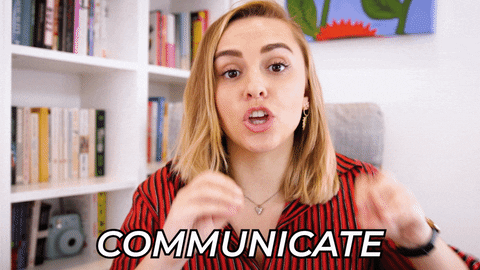Communication is the backbone of workplace culture. It’s the thing that shapes trust, collaboration and productivity, and it keeps businesses moving and growing… or not.
But despite being one of the best-known soft skills, communication is often misunderstood or taken for granted. There’s no single definition of what good communication looks like – it’s a melting pot of lots of other soft skills, from active listening to empathy to conflict resolution.
Well, we think it’s time we stopped misunderstanding this crucial soft skill. Below, we’re going to dig into what really makes a great communicator, how you can spot a bad one and, most importantly, how you can improve your communication skills.
How do communication skills show up at work?
If you’ve ever spent your weekend fretting about a mysterious ‘We need to talk first thing Monday morning’ message from your manager, or felt put out by a blunt request, or felt like a colleague’s criticism was just a little too personal, you’ll know how big an impact communication can have on your work life.
And we all instinctively know what good communication skills look like. It’s about not just talking, but listening. It’s about speaking with clarity and confidence. It’s about showing empathy, getting the right tone, making use of appropriate body language and so much more.
And it shows up everywhere. From team meetings to quick Slack messages to all-company emails, communication couldn’t be more vital to the way we work. It’s multi-dimensional, and it directly impacts efficiency, productivity, morale, relationships and even employee wellbeing.
From frantic 10pm WhatsApp messages from your boss to the anticlimactic 👍 response to your long, carefully considered Slack update, communication is intrinsically woven into every single aspect of the way we work. That’s why nailing your communication skills really, really matters.
What makes a good communicator?

Good communication is an art, not a science. There’s no single way to become better at communicating, as so much of communication is tied in with being authentic and genuine.
Broadly speaking, some of the key traits and behaviours of strong communicators are:
- Clarity – They make their point without over-complicating and organise their points logically (e.g. ‘First, let’s define the goal, then the steps, then the timeline.’)
- Active listening – They genuinely hear and process others’ perspectives (e.g. ‘I totally hear your point, and I’ll get more information on that for you.’)
- Empathy – They consider how their words land and adapt their approach (e.g. ‘I know this isn’t the news we wanted, but I’m here to smooth the transition.’)
- Openness – They can speak up but also invite dialogue (e.g. ‘Now you’ve seen the plan, any questions?’)
- Adaptability – They adjust their style or tone depending on their audience (e.g. ‘Since we’re sharing this with the execs, I’ll focus on ROI and strategy.’)
For example, imagine a project manager is communicating a tricky shift in timelines.
A strong communicator will be clear and honest, while also acknowledging that these shifts could be challenging for their colleagues. They will listen to colleagues’ concerns and engage in dialogue.
What makes a bad communicator?

Let’s take that same example of a project manager.
A weak communicator may deliver the news flippantly or turn it into a joke. They might be unclear about what this means for the team working hard to meet the deadlines, and won’t invite questions or try to empathise.
The tell-tale signs of a poor communicator include:
- Unclear or vague messages – Leaving colleagues unsure what’s expected of them
- Dominating conversations – Talking at people rather than engaging in a real conversation
- Poor listening – Interrupting, dismissing or ignoring contributions
- Inconsistent tone – Coming across as blunt or passive-aggressive to some people, but sycophantic to their superiors
- Closed mindset – Resistant to feedback or differing viewpoints, and not inviting other perspectives
We’ve all seen these traits at work – whether it’s the manager who blames everyone else for misunderstanding their vague instructions, or the colleague who loves the sound of their own voice, or the intern who rolls their eyes every time they’re asked to do something.
It may feel frustrating in the moment, but the consequences can be much further reaching. Poor communication can lead to misunderstandings, mistakes, duplication of work, conflict, disengagement and poor morale.
How to improve your communication skills
Now we’re onto the really important stuff: if you know your communication skills need a bit of work, or you want to become an even better communicator, how do you do that?
There are a few practical tips you can try out to improve your communication skills at work, so let’s take a look!
- Ask for feedback
Ask a manager or trusted colleague how they rate your communication skills, and what improvements they would suggest. If this feels too awkward, AI tools like ChatGPT can analyse your communication style and give an unbiased perspective on your strengths and growth opportunities. Helix, 5app’s AI skills intelligence tool, can also track and analyse your communication skills in the flow of work and recommend content and AI coaching activities to help you elevate your skills over time.
- Practise active listening
Active listening is a fundamental part of great communication. Communication is a two-way street, and your listening needs to be just as good as your speaking (or writing) to ensure people feel comfortable coming to you with questions, ideas and concerns. Working on your active listening skills will contribute to better overall communication skills, so try to work on both in tandem. As a bonus, Helix can also help with active listening!
- Tailor communication to your audience
Not all audiences are made equal, and your CEO will expect a different tone to your direct reports. A good place to start with tailoring your communication is in your writing. Tools like Google Gemini or Copilot are great at helping you adjust the tone of your emails, and you can then take these tips and apply them elsewhere (such as to your instant messages or spoken communications). Looking at the responses you receive can also be useful. If your CEO tends to get caught up in unnecessary information, maybe you’re giving too much detail, or if you don’t tend to get responses, it could be that you’re missing the mark with your messages.
- Be clear and concise
If you have a tendency to ramble or get sidetracked with irrelevant anecdotes, it’s worth figuring out how you can get to the point faster. AI tools like ChatGPT can be invaluable here – for instance, if you’re planning a presentation or writing an email and it’s feeling a little wordy, ask ChatGPT (or Gemini, or Copilot) to help you trim it down so people don’t miss the key information.
- Watch your body language
Literally! Watching back recordings of your video meetings will give you a valuable insight into the story your body is telling, even if your words say something different. Look out for microexpressions like frowning, shrugging or shaking your head, which can imply you disagree or disapprove, as well as smiling, nodding or leaning in, which suggest engagement and interest.
Remember that communication is a soft skill, not a personality trait. If you wouldn’t consider yourself a great communicator right now, there’s absolutely no reason you can’t develop your skills over time, so don’t give up hope. Developing these soft skills is all part of cultivating a growth mindset – more to come on that next week!
How Helix can help improve workplace communication
You may have seen us talking about Helix, our new AI skills intelligence platform. The good news is that Helix is ideal for anyone looking to track and improve their communication skills, alongside complementary skills like active listening, change management and coaching (we call them the Core 9).
Helix provides a clear picture of where individuals and teams are strong or need to work on their communication skills in the form of a handy skills heatmap. For instance, maybe your marketing team has exceptionally strong communication skills and should focus their efforts elsewhere, while your accounting team may need a little more guidance to become better communicators.
It also tracks progress over time, allowing both individuals and the L&D team to see how people are improving over time. This empowers managers to coach employees more effectively by spotting skills gaps before they become skills chasms, and recommending the right learning content and coaching interventions to boost communication skills.
Essentially, Helix makes traditionally nebulous communication skills measurable and actionable, turning a vague concept into tangible growth – all backed by real-time data and evidence.
.png?width=1280&name=Core%209_Communication%20(1).png)